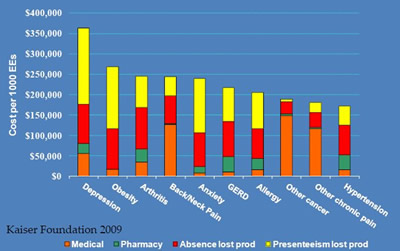In yesterday’s Advisor, , consultant Karl Ahlrichs presented a wellness program that grabbed the interest of 93 percent of employees and spouses. Today, more of his wellness wisdom, plus an introduction to the all-things-HR-in-one website, HR.BLR.com®.
 |
How Big Is the Number?
Most HR managers underestimate the full costs of employee health (or lack thereof), says Ahlrichs. He refers to a study involving auto manufacturers and 171,250 employees.
The study recorded basic medical costs for the measured period—the metric most wellness plans look at—as $509 million.
- But add pharmacy and the number jumped to $623 million.
- And adding lost time pay brought it to $824 million.
- Then adding the impact of absences drove it to $923 million.
- Finally adding performance impact, presenteeism, etc., brought it to a total of $1.24 billion.
Use the bigger number, says Ahlrichs, when you are budgeting for wellness.
Top 10 Claims
And then there’s another way to use big numbers. One of Ahlrichs’ clients found the following changes in its top 10 claims a year after implementing a wellness program:
|
|
2011 |
2012 |
|
Claims over $100,000 |
3 |
0 |
|
Claims $65,000 to $100,000 |
1 |
3 |
|
Claims less than $65,000 |
6 |
7 |
That’s a change that gets CFOs interested.
Ahlrichs also uses charts to help HR managers understand costs of health problems. In the first chart, notice two things, he says. First, you see the surprising amount of costs related to presenteeism. Second, you see the multiplier effect of adding more chronic conditions.

HR budget cuts? Let us help. HR.BLR.com is your one-stop solution for all your HR compliance and training needs. Take a no-cost, no-obligation trial and get a complimentary copy of our special report Critical HR Recordkeeping—From Hiring to Termination. It’s yours—no matter what you decide.
Then, in the second chart, you see various types of costs broken out for specific diseases, expressed as cost per 1,000 employees:

Barriers to Effective Wellness
Ahlrichs offers a list of common barriers to effective wellness programs:
- Lack of employee interest
- Insufficient staff resources
- Inadequate funds
- Failure to engage high-risk employees
- Inability to elicit the support of upper management
- Wellness usually reaches the healthy employee, not the sedentary spouse
- CFOs are skeptical to begin with, and we often track metrics they may not care about or feel are valid.
- Remind CFOs that wellness has ties to customer service and workers’ compensation.
What Else Is Working?
Ahlrichs suggests the following:
- Avoid the “One Size Fits All” approach—Individualize goals/incentives as much as is administratively possible.
- Issue pedometers that collect downloadable data. Get people moving! People can’t cheat. Much.
- Never do open‐ended programs.
- Try not to leave your program on “autopilot”—Your cost drivers can easily shift as employees come and go.
- Consider Value-Based Insurance Design (VBID). Incent those with chronic disease to obtain the right care, at the right time, from the best providers, by lowering costs associated with those treatments.
- Survey your employees to be sure you are getting the motivators right!
Wellness—one of what, a dozen challenges on your desk? In HR, if it’s not one thing, it’s another. Like FMLA intermittent leave, overtime hassles, ADA accommodation, and then on top of that, whatever the agencies and courts throw in your way.
You need a go-to resource, and our editors recommend the “everything-HR-in-one website,” HR.BLR.com. As an example of what you will find, here are some policy recommendations concerning e-mail, excerpted from a sample policy on the website:
Privacy. The director of information services can override any individual password and thus has access to all e-mail messages in order to ensure compliance with company policy. This means that employees do not have an expectation of privacy in their company e-mail or any other information stored or accessed on company computers.
Find out what the buzz is all about. Take a no-cost look at HR.BLR.com, solve your top problem, and get a complimentary gift.
E-mail review. All e-mail is subject to review by management. Your use of the e-mail system grants consent to the review of any of the messages to or from you in the system in printed form or in any other medium.
Solicitation. In line with our general policy, e-mail must not be used to solicit for outside business ventures, personal parties, social meetings, charities, membership in any organization, political causes, religious causes, or other matters not connected to the company’s business.
We should point out that this is just one of hundreds of sample policies on the site. (You’ll also find analyses of laws and issues, job descriptions, and complete training materials for hundreds of HR topics.)
You can examine the entire HR.BLR.com program free of any cost or commitment. It’s quite remarkable—30 years of accumulated HR knowledge, tools, and skills gathered in one place and accessible at the click of a mouse.
What’s more, we’ll supply a free downloadable copy of our special report, Critical HR Recordkeeping—From Hiring to Termination, just for looking at HR.BLR.com®. If you’d like to try it at absolutely no cost or obligation to continue (and get the special report, no matter what you decide), go here.

Hello,
I have been subscribing to your daily HR emails for several years. I have also done an analysis of many articles in public health journals about employee wellness programs. I have never seen breastfeeding (as in, enabling employees to NOT wean their babies when they return to work from maternity leave by expressing breast milk in a private, sanitary space in the workplace) mentioned as a wellness activity, employee choice or employer initiative in all the time I have done this work. Yet breastfeeding impacts every aspect of employee health and employer’s business. I would like to write a guest article for your email list, explaining the importance of breastfeeding to employers’ bottom lines, to employee health, and to morale at the workplace. Please contact me via email and I will discuss this with you.
marti